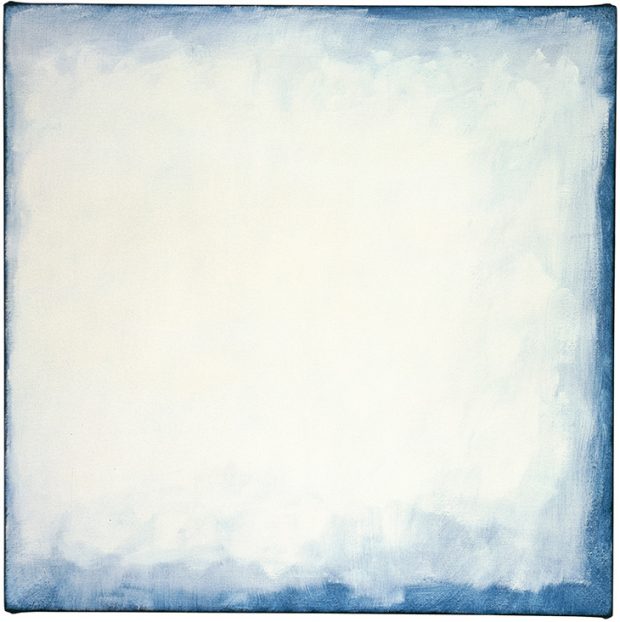The painter Robert Ryman (1930–2019) is best known for his commitment to painting with the colour white. Those lucky enough to have met him will agree on his disarming clarity, concision, and plain-spoken charm – conveyed in his self-deprecating chuckle, his penchant for the cuisine of the southern United States, and his aversion to the term ‘pictures’ when used to describe his painting. The exacting demands he made on the installation and lighting of his subtle works were in service to his oft-stated belief that painting was for ‘pleasure’.
A closer look at Ryman’s only apparently white paintings will reveal tremendous variety. This extends from the irregular black, brown or red rectangles of the 1950s and the multiple thick strokes of searing turquoise that appeared the early 1960s to minutiae such as the flow of enamel on aluminium or the slight sheen of delicately scrubbed oil paint over woven linen canvas. This is not to mention the reappearance of coloured underpainting (often barely under) since about 1993, as well as selectively incomplete coverings that highlighted his supports – not only canvas but paper, mylar, fibreglass, and other materials. Ryman gave us a lot to look at. Taken as a now sadly completed body, the variety of his work is not the result of the artist second-guessing a too-constrictive premise, because it was never a matter of making white paintings, but rather of applying paint in the most visible way possible.
Untitled (1961), Robert Ryman. © 2019 Robert Ryman/Artists Rights Society (ARS), New York

Ryman was inspired to take up painting, when working in the 1950s as a guard at the Museum of Modern Art, by the assured brushwork of Henri Matisse and Franz Kline, as well as the sense of physical presence he intuited from the work of Mark Rothko. Already inclined to emphasise process though his study of jazz under Lennie Tristano, Ryman embarked on a sensual and rigorous engagement with both the materials and ideals of modern painting, remaining, by own estimation, a ‘traditional painter’. Undoubtedly, he was given to vast and uninflected expanses of white. But the very unassailability of these fields draws one’s attention to fluctuations of light, and more often than not, to variations in density and traces of paint application that enjoin the viewer to retrace, as much as possible, the painting’s emergence.
In his review of Ryman’s retrospective at MoMA in 1993, Arthur Danto praised the painter’s ‘formal wit’, but, irritated at the absence of wall labels throughout the show, suggested that ‘[i]n a true spirit of caprice, the proper gesture would have been to play with the labels, enlarging them, printing them backward, pasting them at crooked angles’. What Danto’s musing fails to recognise is the conventional autonomy of the artwork that Ryman, even while highlighting and defamiliarising, continued to respect like a traditional painter. In this way, Ryman was and will remain on the cutting edge of modernist painting, taking it beyond clichés of reduction and exhaustion, and instead positing it as an enactment of focus, intensity, and invention.
Series #27 (White) (2003), Robert Ryman. © 2019 Robert Ryman/Artists Rights Society (ARS), New York

Vittorio Colaizzi is the author of a monograph on Robert Ryman, published by Phaidon in 2017.


